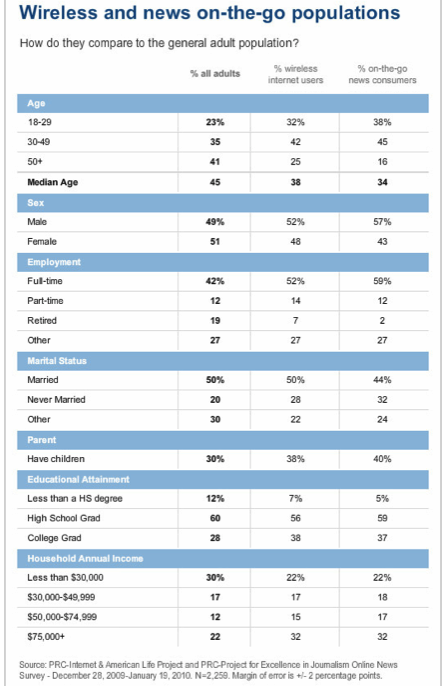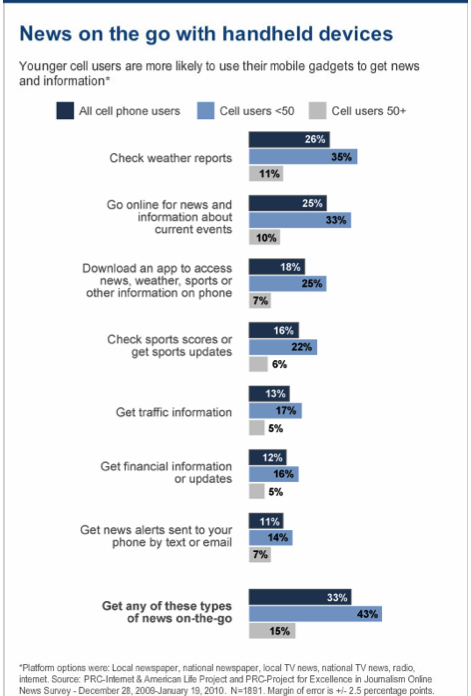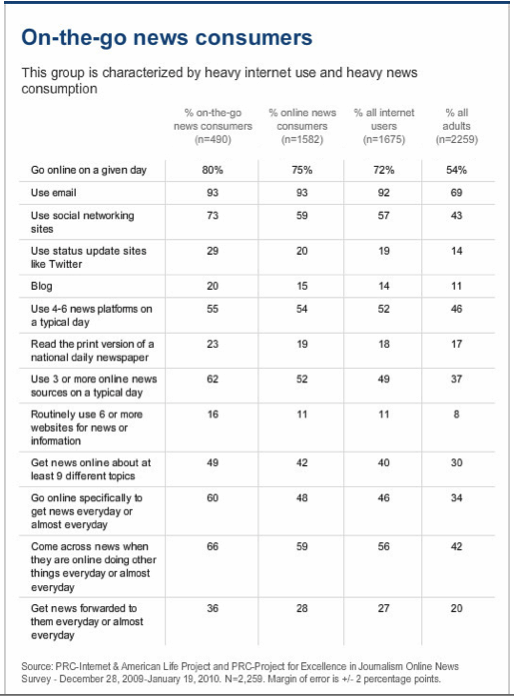Pew Internet study offers Microsoft's mobile strategy a glimmer of hope
How disastrous is Microsoft's hobbled mobile strategy? Today's Pew Internet report, "Understanding the Participatory News Consumer," offers some glimpse and even some hope. The report reveals that more Americans than ever rely on their cell phones for news and other information. Speaking personally, I find the Google News widget on my Nexus One to be indispensable.
Fifty-three percent of US adults "access the Internet wirelessly either through a laptop or a cell phone, BlackBerry or other handheld device," according to the report. Adults? What about measuring teen Internet usage -- and not just cell phones but WiFi devices like Apple's iPod touch? (More griping about Pew overlooking teens will come later in the post.)
"Pew Internet studies have shown that wireless Internet users are different from other online adults in important ways: they are 36 percent more likely than wired Internet users to access the Internet on a given day, and they engage in virtually all online activities (including email, social networking, and blogging) at higher rates than other internet users."
According to Pew, about 80 percent of US adults have cell phones, with 37 percent connecting to the Internet or email. "Overall, 26 percent of American adults say they get some form of news via cell phone -- that amounts to 33 percent of adult cell phone owners and 88 percent of adults who have mobile internet." For the broader category of cell phone users, those seeking news varies by age: 43 percent for those under 50 and 15 percent for those over the big five-oh.
What do these mobile information hounds most care about? The weather (72 percent); news and current events (68 percent); sports scores (44 percent); traffic data (35 percent); financial data (32 percent); and news alerts sent by text or email (31 percent).

Analysts love to breakout data into demographic subgroups, and the Pew team is no exception, identifying "on-the-go-news consumers."
Not surprisingly, on-the-go news consumers maximize their cell phone use. They are 67 percent more likely than other cell phone users to text message, more than twice as likely to take pictures with their phones, and four times as likely to use their phones to instant message. They are also especially heavy Internet users -- 80 percent of this on-the-go group are online on a given day, compared with just 67 percent of other internet users -- and they engage in activities such as blogging (20 percent v. 11 percent ), using social networking sites (73 percent v. 48 percent), and using status update sites like Twitter (29 percent v. 14 percent) at significantly higher rates than other internet users.
Pew surveyed 2,259 US adults, ages 18 or older, between Dec. 28, 2009 and Jan. 19, 2010. However, the number referring to "Internet users" is 1,675. The valuable data is sadly incomplete because PEW ignored teens, which is simply inconceivable to me.
As for what this all means for Microsoft's mobile strategy:
1) More than half of US consumers already get news and other real-time information wirelessly -- laptops more than cell phones. Microsoft should seek to improve news gathering on Windows laptops and transfer the behavior to Windows Phone 7 Series. Tactically, Internet Explorer 8 features like Accelerators and Web Slices are a starting point. New Outlook social networking features are another.

Microsoft can then use established behavior on the desktop and leverage it to Windows Phone 7 Series, by offering similar capabilities. Consumers should be able to sync capabilities and their behavior from mobile Windows desktop to Windows Phone.
2) Microsoft should retool Bing for better news and information dissemination coordinated across the desktop and mobile device -- something Google already is doing with newer features like GPS location-based search and inclusion of news and weather widgets on Android 2.1 handsets. Based on other sections of the PEW report, Microsoft is right to make social networking such an important and pervasive feature in Windows Phone 7 Series.
3) "On-the-go-news consumers" are an ideal demographic for Microsoft. According to Pew Internet: "The typical on-the-go news consumer is a white male, age 34, who has graduated from college and is employed full-time." Many gadget companies target younger (ages 25-34), educated males for a reason. The same demographic going after online information may also be likely to buy bleeding-edge gear -- say, a new Windows Phone.

Pew's study may also help explain some odd findings from last week's AdMob study -- that the majority of Android users are male (73 percent). By comparison, iPhone: 57 percent. Additionally, 51 percent of Android users are between 25 and 44 compared to 42 percent of iPhone users. By the way, 65 percent of iPod touch users are under 17 -- and Pew ignored that market segment in its study? Shame. Shame.
Microsoft should focus some -- perhaps much -- of its initial Windows Phone marketing on males 25-44, provided OS and applications capabilities are information and social sharing focused.
[Editor's Note: All charts are from Pew Internet report "Understanding the Participatory News Consumer."]
